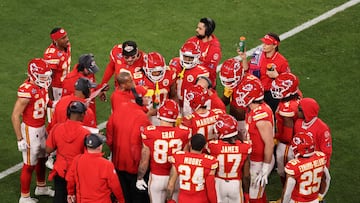How did the Kansas City Chiefs get their name? Origin and meaning
It’s one of the most iconic names in the NFL but few know the origins of the Chiefs’ moniker.

The Kansas City Chiefs get their 2024 season underway on Thursday, taking on the Baltimore Ravens at Arrowhead Stadium.
After a historic run of three Super Bowl wins in five years the Chiefs is undoubtedly one of the most well-known names in the world of sport, but few know the origins of that moniker. Contrary to popular belief, the Kansas City Chiefs did not get their name because of any affiliation or ties to Native American Indian heritage.
In recent years another team with an unpalatable name - the Redskins - has been changed to the Washington Commanders. The Chiefs, however, have a key figure in local history to thank for their name.
NFL KICKOFF. OUR HOUSE. TONIGHT. pic.twitter.com/mmYNotPV1G
— Kansas City Chiefs (@Chiefs) September 5, 2024
Why are Kansas City called the Chiefs?
The origins of the ‘Chiefs’ moniker comes from the decision to move the team to Kansas City in the 1960s. Lamar Hunt was the owner of the Dallas Texans at the time and was convinced by Mayor H. Roe Bartle to move the team to Kansas City.
The name ‘Texans’ clearly needed to be changed to better-suit the new location and long-time franchise official Jack Steadman reportedly suggested the name ‘Chiefs’, referencing Mayor Bartle’s nickname. Other reports claim that Bartle had insisted on having the new team named after him.
Whichever version of the story you believe, it’s widely agreed that Kansas City’s Mayor Bartle was the inspiration for the Chiefs’ name.
Related stories
The confusion of the Native American name theory was not helped by other elements of the Chiefs’ identity that does make reference to Native American culture. The team’s former mascot, a horse named Warpaint, was retired in 2021 as part of an effort to eliminate offensive Native American imagery. However the ‘arrowhead’ logo remains, as does the ‘tomahwak chop’ celebration that is still a part of the team’s fan culture.
A statement on the team website reads: “While the origin of the team’s name has no affiliation with American Indian culture, much of the club’s early promotional activities relied heavily on imagery and messaging depicting American Indians in a racially insensitive fashion. Over the course of the club’s 60-plus-year history, the Chiefs organization has worked to eliminate this offensive imagery and other forms of cultural appropriation in their promotional materials and game-day presentation.”


Complete your personal details to comment